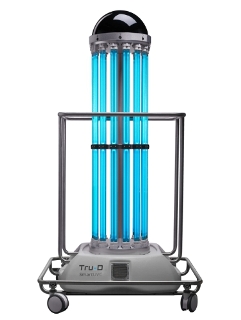Mar 4 2015
Tru-D SmartUVC will exhibit the cutting-edge UV disinfection robot at the Association for Perioperative Registered Nurses' Surgical Conference and Expo 2015 in Denver, Colorado, during Patient Safety Awareness Week March 7 through 11. AORN provides perioperative nurses with resources for safe clinical practice and professional development.
 Tru-D SmartUVC
Tru-D SmartUVC
Tru-D SmartUVC's UV light disinfection technology eliminates detrimental germs and pathogens, which has made it an important asset to facilities elevating their prevention protocols throughout the health care industry. Recently, Tru-D's groundbreaking technology has been used in global health scares involving dangerous bacteria, such Ebola and enterovirus, and in hospitals to protect doctors, nurses and especially patients from harmful hospital-acquired infections that can cause death, readmission and un-reimbursed high costs.
Tru-D brings convenience and security to infection prevention efforts by providing hospitals with an automated device that eliminates infectious cells from a single, central location in the room. With its patented Sensor360 technology, the device calculates the amount of time required to successfully disinfect an entire room, a characteristic not found in any other UV disinfection technology on the market. Tru-D is currently being deployed by health care leaders around the world to eliminate dangerous pathogens, such as Ebola, Middle East Respiratory Syndrome (MERS), influenza, norovirus, Clostridium difficile (C. diff), Methicillin-resistant Staphylococcus aureus (MRSA) and carbapenem-resistant Enterobacteriaceae (CRE), in multiple facets of the health care industry.
"Tru-D continually expands into new markets and hospitals every day," said Chuck Dunn, president and chief executive officer of Tru-D SmartUVC LLC. "The growing use of our device in epidemiologically correct third party clinical research trials and in hospitals around the world allows us to confidently say that Tru-D is not only effective, but it's the best of its kind, using advanced technology to survey a room and calculate what is necessary to eliminate harmful germs and pathogens from all surfaces in the room. Being at the forefront of this technology drives us to remain the best in the industry."
While Tru-D's effectiveness has been proven in nearly a dozen third-party studies, the most recent data, published in Infection Control and Hospital Epidemiology, specifically compares Tru-D to pulsed xenon UV devices on the market. The research results, titled "Evaluation of a Pulsed Xenon (PX) Ultraviolet Disinfection System for Reduction of Healthcare-Associated Pathogens in Hospital Rooms," showed that "pulsed xenon UV was less effective than continuous UV (Tru-D SmartUVC) in reducing pathogen recovery on glass slides with a 10-minute exposure time in similar hospital rooms." Furthermore, "the efficacy of PX-UV was dramatically reduced as the distance from the device (beyond 48 inches) was increased," resulting in the need to move the unit into multiple positions. Previous studies by the same research team concluded that Tru-D SmartUVC effectively delivers total room disinfection, including high touch surfaces in shadowed areas, from a single position near the center of any room. Comparisons to pulsed xenon methods in the published scientific data conclude Tru-D SmartUVC is twice as effective against methicillin-resistant Staphylococcus aureus (MRSA), six times more effective eliminating Clostridium difficile (C. diff) spores and seven times more effective removing vancomycin-resistant Enterococcus (VRE).